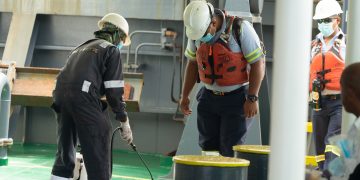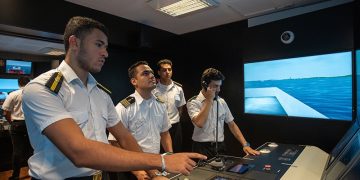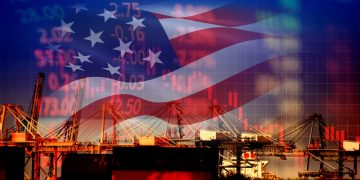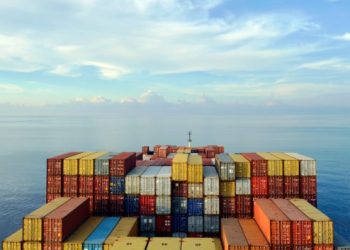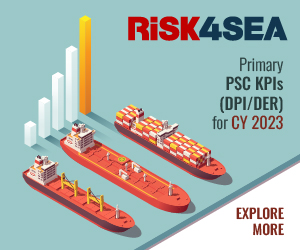The shipping industry’s operating context will alter significantly over the next 15 years. Cargos and markets are changing, and there are new challenges in global ocean governance, argues Mr. Bjørn Kj. Haugland, Executive Vice President & Chief Sustainability Officer (CSO), DNV GL Group.
In September 2015, all 193 Member States of the United Nations adopted a plan for achieving a better future for all – laying out a path over the next 15 years to end extreme poverty, fight inequality and injustice, and protect our planet. At the heart of “Agenda 2030” are the 17 Sustainable Development Goals (SDGs) which clearly define the world we want – applying to all nations and leaving no one behind.
The SDGs are a global call for action to protect the planet, ensure dignified lives for all people, and achieve inclusive economic growth, peace and prosperity. The goals and targets provide global guidance that needs to be implemented by all governments through setting relevant national targets.
However, the SDGs are a call for action to all societal actors, including businesses. The SDGs present an extraordinary opportunity for industry sectors and businesses to align their strategies and business models with global sustainable development needs. As a global industry, shipping has a key role to play in meeting many of the goals. In fact, it already contributes to some of the key targets.
The shipping industry’s operating context will alter significantly over the next 15 years. Cargos and markets are changing, and there are new challenges in global ocean governance. Fuel costs will become less predictable, although technological advances offer the potential for radical improvements in efficiency. The industry is coming under increased pressure to address sustainability concerns throughout their supply chains.
Today, the shipping industry influences – both positively and negatively – a wide range of the issues that are addressed by the Sustainable Development Goals.
The primary tasks of shipping are transportation of goods and passengers and facilitation of a range of ocean-based industries such as fishing, aquaculture, offshore oil and gas, offshore wind energy, ocean renewable energy, marine and seabed mining, marine biotechnology and tourism. Shipping is the center point of the maritime industry, which includes all stakeholders in the value chain such as yards, designers, manufacturers, and service providers. Together, shipping and the maritime industry are a vital part and enabler of other industries in the ocean economy.
At the same time, the ocean space is vulnerable and marine resources are limited, many of them non-renewable and already facing critical limits. Careful management and governance of marine ecosystems and oceans are needed to utilize and protect resources in a sustainable way. The shipping industry must thread the difficult balance of providing sustainable yet affordable services and contribute to governing common resources.
I believe that, with far-sighted leadership, the shipping industry can weather the current market conditions and emerge stronger and more sustainable. I believe the industry has a vital role to play in creating a sustainable, low-carbon economy and that technology will play a transformative role in guiding the industry on a more sustainable path.
Technology will play a transformative role in guiding the industry on a more sustainable path
The Fourth Industrial Revolution
We stand on the brink of a technological revolution that will fundamentally alter the way we live, work, and relate to one another. In its scale, scope, and complexity, the transformation will be unlike anything humankind has experienced before. We do not yet know just how it will unfold, but one thing is clear: the response to it must be integrated and comprehensive, involving all stakeholders of the global polity, from the public and private sectors to academia and civil society.
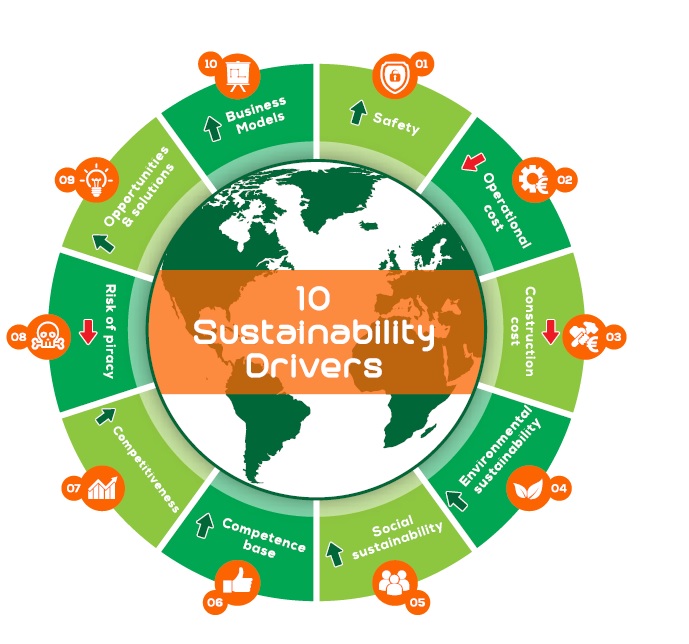
As an example of new technology that may drive sustainability of the next decades, let’s look at how more connected, automated and autonomous shipping drive sustainability to the industry, their customers and to the society at large. The following ten drivers will in my opinion gradually transform the shipping industry towards new sustainable business models.
- Increased safety: Human error is a significant part of 70% to 80% of all accidents at sea. Supplementing human control with reliable technology has the potential to increase safety radically.
- Reduced operational cost: More autonomous shipping brings along a potential to reduce cost. Manning costs typically represent more than 30 % of the total ship operation costs and around 10% of the average trip rates
- Reduced construction costs: No superstructure, accommodation and deckhouses will reduce the construction costs (no air conditioning, heating, ventilation, etc.) Many facilities and systems on board are only there to ensure that the crew is kept fed, safe, and comfortable.
- Increased environmental sustainability: Slow steaming is maybe the most obvious approach to achieve this objective. By diminishing the fuel consumption of a vessel its emissions are reduced equally. Hence the effects of autonomous vessels on a wider deployment of slow steaming will not only contribute towards economic but also significantly towards the environmental sustainability.
- Increased social sustainability: Seagoing professions are increasingly perceived as unattractive today. Sea passages are long and often lacking in variety. Port calls that might offer some change to the daily routine are short nowadays allowing for little time to spend ashore. Mariners are confronted with a disconnection from their social environment due to the long-time periods they spend away from family and friends. The concept of autonomous vessels offers an opportunity to increase the attractiveness of seafaring. The seafarers of the future control and monitor the routing and navigation of autonomous ships from a shore side operations centre. At the same time, they can live close to their families and follow ordinary working hours.
- Stronger competence base: As the operations gradually move from sea to shore the competence requirements will develop and attract talents with new complementary competencies that will strengthen the shipping industry.
- Increased competitiveness: Smarter ships with increased cargo capacity and reduced operational cost will make the shipping industry more competitive towards other modes of transportation. E.g. there are a potential to increase the trade volumes by moving cargo from shore to sea and reduce the density of polluting cargo trucks on the roads.
- Reduced risk of piracy: There would be no human hostage situation from piracy and a remote-controlled ship can be “shut down” from shore making it difficult for pirates to take over the control of the vessel (they must bring their own tug to take control).
- Opening of new opportunities and solutions: A ship design with less superstructure, deckhouses and equipment to facilitate an on-board crew will have more space for cargo and open for new solutions for automatic loading and unloading.
- New Business models: Going forward we will see business model innovation through the entire value chain of shipping on top of a more advanced and connected ship technology platform.
Shipping 4.0
The road towards autonomous shipping will be stepwise and start with small specialized cargo vessels for costal and local traffic. There are many levels of autonomy and we will gradually see more automation for all vessels as technology matures. Different levels of autonomy will gradually expand to increasingly wider operational area and larger ships. The regulatory and legal frameworks will need to be developed to facilitate a safe and responsible uptake of new technology and solutions.
Application of new technology has a huge potential to drive economic, environmental and social sustainability in the shipping industry and will in my opinion be essential to drive the industry towards the sustainable development goals. Stay tuned for Shipping 4.0!
By Bjørn Kj. Haugland, Executive Vice President & Chief Sustainability Officer (CSO), DNV GL Group
The views presented hereabove are only those of the author and not necessarily those of SAFETY4SEA and are for information sharing and discussion purposes only.

Bjørn Kjærand Haugland is Executive Vice President and the Chief Sustainability Officer in DNV GL Group. In his capacity as CSO for DNV GL group he oversees the groups sustainability performance and drives company-wide sustainability initiatives. Haugland has extensive experience assisting multinational companies in areas such as sustainability, climate change and innovation.
Haugland is board member in StormGeo, the University of Bergen, WWF and Global Maritime Knowledge Hub. He is responsible for the Global Opportunity Report and the Global Opportunity Explorer, a joint initiative together with UN Global Compact and Sustainia.
Haugland started his career in DNV in 1991 and has held various management positions in Norway and abroad. He worked in Korea in the period 1995 to 1997. From 2004 to 2008 he was the Country Chair and responsible for DNV’s operation in Greater China.
Haugland has a M.Sc. in Naval Architecture – Marine Structures and Hydrodynamics – from The Norwegian Institute of Technology in Trondheim and he attended the “Strategic International Leadership” programme at International Institute for Management Development (IMD).
He is recognized in the global debate on sustainability and technology and he has his own blog on the Huffington Post and he is regularly writing articles for Recharge, Teknisk Ukeblad and Sysla Maritime and on DNV GL’s own blog sites.









